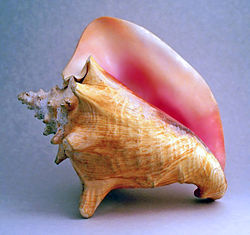Conch
| Conch | |
|---|---|

| |
| An adult Queen Conch shell | |
| Scientific classification | |
| Kingdom: | |
| Phylum: | |
| Class: | |
| Superorder: | |
| Order: | |
| Suborder: | |
| Infraorder: | |
| Superfamily: | |
| Family: | |
| Genus: | Strombus
|
| Species | |
A conch is a sea-dwelling mollusc. It is a marine gastropod. The ch at the end of 'conch' may be pronounced hard or soft.
Many other gastropods have common names with conch in them. They are however not true conches, in the family Strombidae. One such example is the Horse Conch (Pleuroploca gigantea). The genus Strombus is made up of the true conches.
While most Strombid species are extinct, at least 65 species still exist. Of these, most are in the Indo-Pacific Oceans while six are in the greater Caribbean region. Living true conch species include the Queen Conch, Strombus gigas, and the West Indian Fighting Conch (Strombus pugilis).
Many conch, such as the Queen Conch, are found among beds of sea grass in warm tropical waters.
Strombus gigas is included in Appendix II of the UNEP's CITES list of endangered species and international trade is heavily restricted.[1]
Anatomy[change | change source]

Conches have spirally constructed shells. Depending on species (or aberrant growth patterns), shell growth can be sinistral (left-handed) or dextral (right-handed).
Conches have long eye stalks, a long and narrow aperture, and a siphonal canal with an indentation near the anterior end. This indentation is called a stromboid notch. They also have a foot ending in a pointed, sickle-shaped, horny operculum. They grow a flared lip on their shells upon reaching sexual maturity.
Conches have a characteristic leaping motion, using their pointed, sickle-shaped, horny operculum to propel themselves forward. They lay eggs in long, gelatinous strands.
Human use[change | change source]

The animal inside the shell is eaten, either raw, as in salads, or cooked, as in fritters, chowders, gumbos, and burgers. In East Asian cuisines, the meat is often cut into thin slices and then steamed or stir-fried. Conch meat is also often confused with Scungilli, which is more accurately whelk meat.
Conch shells are sometimes used as decoration, as decorative planters, and in cameo-making. As with other mollusk shells, they are ground up into an ingredient in porcelain. In classic Mayan art, conches are shown being utilized in many ways including as paint and ink holders for elite scribes, as bugle or trumpet, and as hand weapons (held by combatants by inserting their hands in the aperture).
In some countries, cleaned Queen Conch (Strombus gigas) shells or polished fragments are sold, mainly to tourists, as souvenirs or in jewelry. Without a permit however, export is a breach of CITES regulations and may lead to arrest [2] Archived 2007-02-06 at the Wayback Machine. This is most likely to occur on return to the tourist's home country while clearing customs. In the UK conch shells are the 9th most seized import. [3]
Conch shells are occasionally used as a building material, either in place of bricks or as bulk for landfill.
It is also believed to be used as a weapon by the earliest Caribbean natives.[source?]
Playing the conch shell[change | change source]
Conch shells are sometimes made into crude bugles by removing the small tip of the shell to form a mouthpiece. Such instruments are used in the Pacific Islands as well as in many parts of Asia. While lacking the range capabilities and tonal quality of brass instruments, the conch shell is still an interesting instrument to play. As it has no mouthpiece or valves, the embouchure in shell playing is critical. Most shells will only naturally play one note, but with pitch manipulations, multiple sounds can be achieved. The insertion of the hand and the placement of the fingers will also change the pitch of the shell. The conch shell is said to be the musical instrument of mermaids and mermen. Steve Turre is the leading innovator of the shell. It is sometimes found in classical works, such as the symphony piece "La Noche de Los Mayas", or "Night of the Mayas", which was premiered in 1939 with Jacob Watkins on percussion and conch.
Religious symbolism[change | change source]
Hindu tradition[change | change source]

The conch shell is a major Hindu article of prayer, used as a trumpeting announcement of all sorts. The God of Preservation, Vishnu, is said to hold a special conch, Panchajanya, that represents life as it has come out of life-giving waters. In the story of Dhruva the divine conch plays a special part. The warriors of ancient India would blow conch shells to announce battle, such as is famously represented in the beginning of the war of Kurukshetra in the Mahabharata, the famous Hindu epic. The conch shell is a deep part of Hindu symbolic and religious tradition. To this very day, many Hindus use the conch as a part of their religious practices, blowing it during worship at specific points, accompanied by ceremonial bells.
See also: Krishna
Buddhist tradition[change | change source]
Buddhism also has incorporated the conch into its symbolism. See: Buddhist symbolism.
Literature[change | change source]
William Golding's Lord of the Flies features frequent references to "The Conch". In the novel, a conch shell is blown to call the other boys together. It is held by whoever is speaking at meetings, symbolically representing democracy and order. When Roger, Jack's lieutenant, smashes the shell, it is a sign that civilized order has collapsed and Jack's domination has begun.

